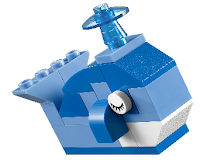 |
| Lego 3-in-1 Classic Blue Creativity Box - A good value on a great therapy tool |
I just love Lego's small 3 in 1 sets! All the great advantages of working with Legos, in small sets that only cost about $5. Lego is one of my most often recommended toys because they help build so many different skills. If you haven't read my blog about Building Skills with Construction Toys you can find it here. Lego 3-in-1 Classic Blue Creativity Box is a great activity for making a 3D models by following directions from a 2D instruction guide. A natural activity for using 2 hands to place and pinch pieces. Small pieces are perfect for practicing in-hand manipulation skills and fine motor precision and a nice activity for a therapy session as they can be completed in a much shorter time than the larger LEGO models. The kids I work with can assemble one of these in 15-20 minutes. Of course that will depend on who you give it to.
Kids are typically very pleased with the finished product once they see it come together into a toy. All 3 models cannot be made at the same time as they use the same pieces. Legos 3-in-models come in different themes (trucks, cars, etc.) and colors like this blue set (red, orange, green, etc.).
UPDATE: Since this post I have found two Lego sets that each include 24 small models. Check them out. Lego Build Up 40222. Lego Build Up 40253.
Try this with any LEGO set:
- Give a few minutes to examine the pieces at the beginning so that the person can examine the different shapes and how they snap together.
- Set the piece(s) for each step in front of the beginner until he has gotten used to identifying pieces.
- Turn pieces on the table so that they can't be picked up by the child in the correct orientation. Ask him to turn each piece in-hand after picking it up.
- Place a piece in the individual's palm, or at the base of the fingers, in the incorrect orientation and ask him to bring it to the fingertips and turn it in-hand for placement.
- Give the beginner one piece at a time while building and point to the piece on the guide to show where it should go.
- Ask the child to pick up the model and hold it in one hand while adding pieces with the other hand so that both hands works together while adding pieces (instead of adding pieces while the model is on the table).
- Show the child how to hold the model with the non-dominant hand while "pinching" the new part on with the dominant hand.
- Place the pieces for each step on the non-dominant side so that the individual will have to cross midline to pick them up. Instruct him not to lean to the side as he reaches across.
- Ask "what is different" at each new step in the instruction guide to focus on where the new parts will go.
- Keep the unused pieces in a pile so that the child will have to search for each needed piece. Turn some of the pieces upside down or half cover them so they will look different from the picture.
- Advise the child to hold the model in the same orientation as the one in the picture to aid in orienting pieces.
- Catch mistakes as they happen, as an incorrectly placed piece may throw off the rest of the project. Tell the individual that his model does not look exactly like the picture and see if he can identify the mistake and correct it on his own before jumping in to help.
- Work on executive functioning skills, visual discrimination, visual closure, visual form constancy, spatial relations, figure ground, eye-hand coordination, in-hand manipulation, manual dexterity, precise fine motor control, using two hands together, finger strength, play and leisure exploration and participation
If you are interested in purchasing this item or just want more information, click on the image below.




No comments:
Post a Comment
Thank you for taking the time to comment.